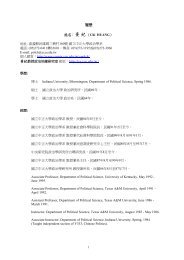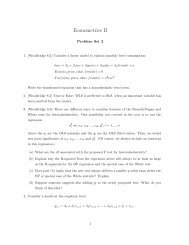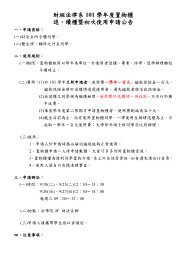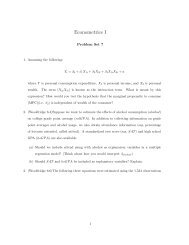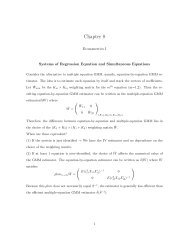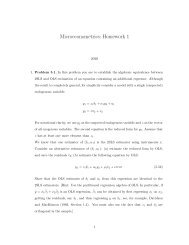Chapter 10 . <strong>Nucleotides</strong> <strong>and</strong> <strong>Nucleic</strong> <strong>Acids</strong>9. Based on the information in Table 10.5, describe two different 20-base nucleotidesequences that have restriction sites for BamHI, PstI, SalI, <strong>and</strong> SmaI. Give the sequencesof the SmaI cleavage products of each.Answer: Table 10.5 lists type II restriction endonucleases, their recognition sequence, where inthe sequence the enzyme cuts in addition to other information. BamHI, PstI, SalI <strong>and</strong> SmaI allrecognize six-base restriction sites. Since we are asked to produce a 20-base sequence we aregoing to have to have restriction sites overlap. We are not asked to order the sites so this leaveus free to try several combinations.EnzymeBamHIPstISalISmaIRecognitionSequenceGGATCCCTGCAGGTCGACCCCGGGLooking at the recognition sequences it is clear that having BamHI <strong>and</strong> SmaI adjacent to eachother will allow a two-base overlap (of G’s or C’s, depending on order). So we could start outwith either of these two:1. GGATCCCGGG or 2. CCCGGGATCCTo 1. we could add PstI <strong>and</strong> SalI sites with single base overhangs as follows:CTGCAGGATCCCGGGTCGACDigestion of this oligonucleotide with SmaI would produce:CTGCAGGATCCC <strong>and</strong> GGGTCGACTo 2. we could add PstI <strong>and</strong> SalI sites with single base overhangs as follows:GTCGACCCGGGATCCTGCAGDigestion of this oligonucleotide with SmaI would produce:GTCGACCC <strong>and</strong> GGGATCCTGCAGAlternatively, we could have started with the BamHI/SmaI overlapped DNA on an end <strong>and</strong> thenadded in the other sites.For 1. we would get:GGATCCCGGGTCGACTGCAGDigestion of this oligonucleotide with SmaI would produce:GGATCCC <strong>and</strong> GGGTCGACTGCAGFor 2. we would get:CTGCAGTCGACCCGGGATCCDigestion of this oligonucleotide with SmaI would produce:CTGCAGTCGACCC <strong>and</strong> GGGATCC10. The synthesis of RNA can be summarized by the reaction:n NTP (NMP)n + n PPiWhat is the •Gº’overall for synthesis of an RNA molecule 100 nucleotides in length,assuming the •Gº’ for transfer of an NMP from an NTP to the 3’-O of polynucleotidechain is the same as the •Gº’ for transfer of an NMP from an NTP to H20? (Use datagiven in Table 3.3.)Answer: From Table 3.3 we are informed that the •Gº’ for hydrolysis of ATP to AMP <strong>and</strong> PPi is –32.3 kJ/mol. This reaction is in effect a transfer of AMP from ATP to water. We are allowed toassume that transfer of AMP from ATP to the 3’ end of a polynucleotide chain has •Gº’ of +32.3kJ/mol. To make a polymer 100 nucleotides long let us start with hydrolysis of a single NTP toNMP <strong>and</strong> PP with a very favorable •Gº’ of –32.3 kJ/mol. The NMP would then be used in atransfer reaction with NTP to make the first phosphodiester bond with an unfavorable •Gº’ of151
Chapter 10 . <strong>Nucleotides</strong> <strong>and</strong> <strong>Nucleic</strong> <strong>Acids</strong>+32.3 kJ/mol. To make 99 phosphodiester bonds, the number in a 100-base-longpolynucleotide, the reaction would have to be repeated 98 times. Thus,•Gº’overall = -32.3 +99 x 32.3 kJ/mol = 3,165.4 kJ/molIf we were to have simply made 99 phosphodiester bonds it would require:•Gº’overall = 99 x 32.3 kJ/mol = 3,198 kJ/molHowever, the RNA would have a triphosphate at its 5’ end.11. Gene expression is controlled through the interaction of proteins with specificnucleotide sequences in double-str<strong>and</strong>ed DNA.a. List the kinds of noncovalent interactions that might take place between a protein<strong>and</strong> DNA.b. How do you suppose a particular protein might specifically interact with a particularnucleotide sequence in DNA? That is, how might proteins recognize specific basesequences within the double helix?Answer: a. The weak forces are hydrophobic interaction, van der Waals interactions, hydrogenbonds <strong>and</strong> ionic bonds. Of these we might not expect excessive hydrophobic interactions tooccur between a protein <strong>and</strong> dsDNA because dsDNA presents virtually little in the way ofhydrophobic surfaces to the solvent. The bases themselves are hydrophobic but they arestacked in dsDNA. One might expect hydrogen bonding to occur between a protein <strong>and</strong> bases ina DNA sequence. One might also expect ionic bonding between the negatively-chargedsugar/phosphate backbone of DNA <strong>and</strong> positively-charged amino acid residues from arginine<strong>and</strong> lysine.b. Without unwinding dsDNA a protein would have to make base-specific interactions via eitherthe major groove or minor groove. There is more information regarding the identity of base pairsin the major groove. In addition, the dimensions of an α-helix are compatible with the space inthe major groove. Thus, one might expect proteins to bind via the major groove.12. Restriction endonucleases also recognize specific base sequences <strong>and</strong> then act tocleave the double-str<strong>and</strong>ed DNA at a defined site. Speculate on the mechanism by whichthis sequence recognition <strong>and</strong> cleavage reaction might occur by listing a set ofrequirements for the process to take place.Answer: Restriction enzymes bind double-str<strong>and</strong>ed DNA at sites that have two-fold rotationalsymmetry <strong>and</strong> they cleave both str<strong>and</strong>s at identical places on the DNA. For this event to occurefficiently, both str<strong>and</strong>s have to be recognized <strong>and</strong> cleaved at the same time. An efficient way ofdoing this is to have the enzyme function as a homodimer binding to the major groove.One could envision a restriction endonuclease functioning as a monomer, binding to dsDNA viathe major groove <strong>and</strong> hydrolyzing a single str<strong>and</strong>. To simultaneously cleave the second str<strong>and</strong>would require a second catalytic site on the enzyme. Alternatively, the enzyme might, uponcleavage of one str<strong>and</strong>, release from the DNA <strong>and</strong> rebind to it to cleave the second str<strong>and</strong>. Nicksin dsDNA can unwind, making it difficult to be recognized by an enzyme that initially bound todsDNA. One could imagine a DNA binding site that recognizes single-str<strong>and</strong>ed DNA sequences.This, however, would complicate binding to dsDNA. So, one could envision a protein with twocatalytic sites or two DNA binding sites, one ssDNA specific <strong>and</strong> one dsDNA specific.Dimerization, however, seems like a simple way to avoid these complications.13. A carbohydrate is an integral part of a nucleoside.a. What advantage does the carbohydrate provide?Polynucleotides are formed through formation of a sugar-phosphate backbone.b. Why might ribose be preferable for this backbone instead of glucose?c. Why might 2-deoxyribose be preferable to ribose in some situations?Answer: a. A nucleoside is a base in glycosidic linkage to a sugar. Bases are poorly watersoluble<strong>and</strong> attachment to a sugar will improve their water solubility. Sugars present numeroushydroxyl groups that contribute to water solubility <strong>and</strong> provide attachment points for othermolecules.152





